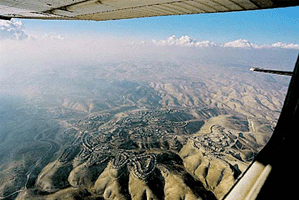Weizman, Eyal. 2007. Hollow Land: Israel’s Architecture of Occupation. London: Verso.
All military occupations are spatial operations and strategies. But the Israeli Defense Forces (IDF) and government have managed to make space the continuation of war by other means. New dimensionalities of space are being produced in the process: the politics of verticality, “depth,” and separation, and six dimensional space (three Israeli, three Palestinian). People who have a problem with equating things in Israel/Palestine to apartheid or Jim Crow should really read this book. The architecture of occupation surveyed in the book is not simply political, but “politics in matter” (5).
Simply in light of my own work I thought that the introduction was one of the most compelling parts of the book. He introduces the concept of “anchor points,” which are key nodes of a spatial framework that are used to quietly expand the territorial encroachment onto Palestinian lands. But they are also strategic spots in the topography of a region, meaning that they offer stepping-stones to control much larger swaths of land.
 I like the way Weizman describes frontiers: “Against the geography of stable, static places, and the balance across linear and fixed sovereign borders, frontiers are deep, shifting, fragmented and elastic territories. Temporary lines of engagement, marked by makeshift boundaries, are not limited to edges of political space but exist throughout its depth. Distinctions between the ‘inside’ and ‘outside’ cannot be clearly marked” (4). A complex array of actors are all making this space—though the military is clearly the most powerful—but it also involves militants, planners, NGOs, international actors, etc. They all “play their part in the diffused and anarchic, albeit collective authorship of its spaces” (5).
I like the way Weizman describes frontiers: “Against the geography of stable, static places, and the balance across linear and fixed sovereign borders, frontiers are deep, shifting, fragmented and elastic territories. Temporary lines of engagement, marked by makeshift boundaries, are not limited to edges of political space but exist throughout its depth. Distinctions between the ‘inside’ and ‘outside’ cannot be clearly marked” (4). A complex array of actors are all making this space—though the military is clearly the most powerful—but it also involves militants, planners, NGOs, international actors, etc. They all “play their part in the diffused and anarchic, albeit collective authorship of its spaces” (5).
“In this unique territorial ecosystem, various other zones—those of political piracy, of ‘humanitarian’ crisis, of barbaric violence, of full citizenship, ‘weak citizenship’, or no citizenship at all—exist adjacent to, within or over each other” (7). “The various inhabitants of this frontier do not operate within the fixed envelopes of space—space is not the background for their actions, an abstract grid on which events take place—but rather the medium that each of their actions seeks to challenge, transform or appropriate” (7).
The Israeli government strategies are composed by a complex mix of chaos and order, the legible and illegible, the legal and illegal. This blurring is both practical and semantic, and it contributes to “one of Israel’s foremost strategies of obfuscation: the promotion of complexity—geographical, legal or linguistic”—he calls the latter a “sophisticated semantic laundering” (8).
Since each chapter of the book is a historical episode, I thought it was great how the book blended the historical and the spatial in a constantly evolving configuration based on the “different spatial practices and technologies of control and separation” (15).
In the first chapter of the book, we see the politics of place, spirituality, memory as expressed through the building bylaws that made construction be built of “Jerusalem stone.” The chapter also focuses on the various ways that the city itself began expanding and encroaching on non-Jewish enclaves. The space of the city began to be marked by Jewishization of spaces via archaeology and agriculture. The former “providing an alibi for new colonization that could be argued as a return to sacred patrimony” (39). The same was done visually with the bylaws around stone construction that was meant to evoke an authenticity of a historical Jewish territorial homeland. More or perhaps not so subtly Palestinians were crowded, cultured and priced out of desirable spaces: the refusal of building permits by Israeli authorities meant they were crowded in old dilapidated homes without permits to expand or improve them; neighborhoods are also coded as Jewish making them hostile places for “others”; as Palestinians are forced to leave the city for cheaper and better living arrangements in Palestinian areas, they consequently loose their Israeli residency status and the government benefits that entails.
Weizman then describes the military vision and innovations introduced by Ariel Sharon, particularly his conception of a network of mobile strongpoints in “depth.” This chapter also emphasizes the importance of the frontier in the shaping of Israeli nationalism. Depth describes a more networked, mobile, flexible and agile system of attack and defense. “The category of ‘depth’ is thus not only spatial but conceptual, and is used to describe the level of synergy between various elements that compose a military system. The degree of a system’s depth lies in its distributed capacity to reorganized connections, and the degree to which these connections can permit, regulate and respond to information flow from strongpoints positioned in other [key] areas of the battlefield” (67). Thus, the importance of “anchor points” as prefigurative “strongpoints.” Sharon is an important figure here because he embodies the move of these military concepts and strategies into the “civilian” fields of settlement construction and suburbanization. This material construction of space also followed along the established forms of military logics in maintaining various strategic forms of visibility.
 This is particularly true for the way in which settlements battled for the hilltops, both for military-strategic reasons as anchor points but also because of their role in religious- and place-based kinds of myth-making about belonging. Weizman explores the politics of the settlements more closely in terms of the optics they represent and produce, both to onlookers (awe/fear/humiliation/envy) and their residents (surveillance/dominance/pity). The Palestinians in the distance, paradoxically, produce the pastoral scenery sought by the colonialist surbabanite Israeli.
This is particularly true for the way in which settlements battled for the hilltops, both for military-strategic reasons as anchor points but also because of their role in religious- and place-based kinds of myth-making about belonging. Weizman explores the politics of the settlements more closely in terms of the optics they represent and produce, both to onlookers (awe/fear/humiliation/envy) and their residents (surveillance/dominance/pity). The Palestinians in the distance, paradoxically, produce the pastoral scenery sought by the colonialist surbabanite Israeli.
These settlements also set an important precedent in which their illegality was justified by their function within Israeli “security” interest, but for this, they were termed temporary. They were legal as long as they played into security logics and were (on paper at least) temporary. Of course, security threats as an infinitude makes the settlements permanent. If war and peace are indistinguishable, then so are security threats (and thus settlements) (105). The settlements themselves are often treated as military units.
The wall itself plays on these same logics of permanence/impermanence, as a continual state of emergency. The government offers the inevitable reroutings of the wall to claim its temporariness—Weizman again employs the concept of elasticity. “No longer able to translate the intensely contradictory force-field into a complex, albeit linear, geometry, the Wall also ceased being a singular, contiguous object, and broke intro separate shards, fragments and discontinuous vectors” (176). Planners are now trying to weave together the two territorial separate but overlapping formations that have been produced via settlements, military occupation, and the wall construction.
The urban militarism chapter is brilliant and I had read before in essay form. The “inverse geometry” of the swarm and infestation become the strategy of the IDF in seizing or “cleaning out” a refugee camp. This strategy is partly a response to insurgent tactics themselves: “Indeed, military attempts to adapt their practices and forms of organization has been inspired by the guerrilla forms of violence that confront it. Because they adapt, mimic and learn from each other, the military and the guerrillas enter a cycle of ‘co-evolution’. Military capabilities evolve in relation to the resistance, which itself evolves in relation to transformations in military practice” (189). The slide on page 199 is really revealing.
Military reformers drew heavily on Deleuze and Guattari’s concepts of “rhizome” and “war machine”; they also drew on Debord and Blanqui. But Weizman suggests that such theorists did not really introduce or even inspire these military innovations, which were already well underway, but rather that they provided strategist with a conceptual language (and authority) to argue against those with more traditional views of warfare. Finally, the last chapter discusses the brute force of the politics of verticality by discussing how the occupation has gone aerial” after its retreat from Gaza.
The stuff on territory and the frontier are particularly relevant for me, especially this thinking of territory as elastic and the notion of anchor points. His focus is quite heavy on the built environment, which is less relevant for me, but I think that nonetheless produced space and its control is clearly part of any military strategy. The stuff on visibility and invisibility, which draws heavily on Foucault’s discussion in Discipline and Punish, seems like another productive discussion for my own work. He, like Foucault, talks about it much more in terms of the (in)visibility of power, but how can we also think about this productiveness of the (in)visible in terms of economic power and legality?

Pingback: Brenner and Elden: Production of Territory | Territorial Masquerades
Pingback: Spatiality and Power | Territorial Masquerades
Pingback: Isreali weizman | Transportesjmg
Pingback: Interweb Motley # 11 | Territorial Masquerades